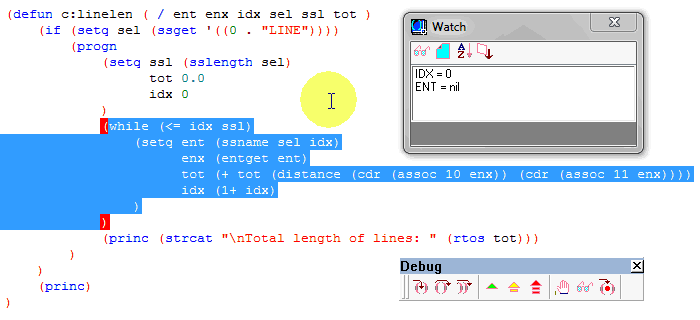

(defun c:MassCent(/ sset1 slng1 cnt1 cnt2 clist sent1 xlist ylist zlist xpt ypt zpt cpt rad vol1 vlist ucp ut2) The null function exists largely for historical reasons, more specifically because some early LISP implementations did not treat the empty list and NIL as equivalent, and NULL was required to determine if a list was. Here is the one that will make the right prompt per units user selects. While some may view not and null as different, in AutoLISP they're functionally identical. Things from solids if you like, but here are the ones you specified. If you only need the volume also then try this one. 1 yazn ve enterlayn Çizim deeri/Hesap deeri 1 alnrsa: Bu durumda çizimde ekil kaç birim olarak çizilmise ayn birim üzeinden alan ve çevre hesaplanr. You can get more things from solids if you like, but here are the ones you specified. Komut satrna 'ALAN-CEVRE-GM' yazn ve enterlayn. This is useful for erasing objects that may have gone astray in a layout tab. (setq vlist (append vlist (list (vlax-get sent1 "Volume")))) Here’s is a great little routine that will erase everything that is outside of or crosses a selection window that you create. (defun c:MassCent(/ sset1 slng1 cnt1 cnt2 clist sent1 xlist ylist zlist xpt ypt zpt cpt rad vol1 vlist ucp) Something as well, but I like this method because it outputs the masspropįile, which allows me to get volumes also, for additional calcs.

Not to mention getting calcs done much faster. Is there a way to get ssget to terminate everytime a selection is made, regardless of enter.

SSGet allows the user to select individual entities, but just keeps adding them to a buffer until the user presses enter. START Setting the limits, erasing everything in the screen, setting the snap and grid, zooming out of the screen. I already gave you a list of all the functions. This routine will make my life a lot simpler, Put another way: Entsel returns the entity name (and some more) immediately when the user selects the entity. Now I'm going to talk about all the functions of the AutoLISP program. It should be sufficientįor what I am doing, but how would you get it to more decimal places? The only thing additional I could see (am I never happy?) is that theĬenter point it uses is only to one decimal place. (setq i (open "D:\\lisp\\centroid.mpr" "r")) (command "massprop" x "" "y" "D:\\lisp\\centroid.mpr") ( defun c:LBL ( / foo AT:GetSel pnts pline lwpline dist e1 e2) Draw (LW)Polyline between two selected curves (at midpoint of.
(command "ucs" "w") I've had problems not being in World Specify the output polyline (LWPoline or Polyline) REOutput file to the D drive per the way I have my machine set up, but that's This AutoLISP routine: (command circle PAUSE 2) looks like this at the Command Line: See also Processing Entities within a Selection Set with autolisp in AutoCAD. Sphere command to draw a sphere of user specified size. I made it so that it allows multiple solid selection, and also it uses the I finally got it!! I basically used your routine, but modified it slightly. I don't know how elegante it is, because of my limited list knowledge, but it works. It works for my test drawing and if you want to do more things variable "cpt" is the center centroid point of all the solids selected with this command. (setq cpt (mapcar '(lambda (x) (/ x cnt1)) cpt)) (repeat (fix (- (vl-list-length clist) 1)) (setq clist (append clist (list (vlax-get sent1 "Centroid")))) (if (vlax-property-available-p sent1 "Centroid") (setq sent1 (vlax-ename->vla-object (ssname sset1 cnt2))) (prompt "\nSelect solids for centroid location. ) end of duct functionI am relatively new to vLisp and such, but am very keen to get my teeth into it - and excited to see the results of joining the AUGI forums.(defun c:MassCent(/ sset1 slng1 cnt1 cnt2 clist sent1 xlist ylist zlist xpt ypt zpt cpt) (ssget "_c" cable_start_point cable_end_point (vlax-curve-getpointatparam ename postparam) Explanation: (entnext) with blocks Command:(setq B1 (tblnext 'BLOCK' T)) ((0. This is done through the block definition table. (vlax-curve-getpointatparam ename preparam) Just as (entnext) works with old style polylines and attributes in a block, it may also be used to extract the entities that make up a block.


 0 kommentar(er)
0 kommentar(er)
